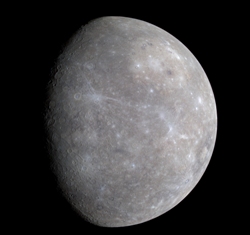 Visitors from Mercury?
Visitors from Mercury?
There has been speculation from time to time whether certain meteorites emanate form the planet Mercury. There has been very little publication on whether large scale impacts onto Mercury could reach our planet. Gladman and Coffey1 have recently covered this topic admirably. A small minority of the total meteorite population is reliably attributed to impact ejection from Mars: there is no proof of this but gaseous inclusions within them match the Martian atmosphere in composition and it is a case of applying ‘Occam’s razor’, they must emanate form a planet and Venus’s atmosphere would prevent ejection from there. True, there remains the small, innermost planet, Mercury, with a surface revealed by Mariner 10 to be pitted with impact craters; but recent imagery has also revealed many volcanic features (Geoscientists passim.).
The launch speed needed to escape the gravity of Mercury is intermediate between that of the Moon and of Mars, so escape is feasible. This is the only planet where impact speeds routinely exceed the escape speed by 5 to 20 times, so many impacting objects will escape its gravitational pull, a large fraction achieving heliocentric orbit. These authors conclude that the time taken for delivery on Earth would be ~30 Myr, and several percent or the material ejected from Mercury would reach Earth (slightly less than from Mars, and the same amount would reach Venus).
Since all the material ejected is Mercury-crossing in its orbit, much of it would be re-accreted. This is of little significance to the feasibility of Earth delivery, but is of interest when considering the possibility of impact-stripping of the mantle of the proto-Mercurian planet by a giant collision, recently reviewed
4. This suggestion has been advanced to explain the high density of Mercury, and its postulated large core. Gladman and Coffey conclude that this stripping could only operate if the ejected mantle fragments were small enough to be dragged into the Sun on the timescale of a few million years, otherwise they would be re-accreted.
As to Earth delivery of Mercury-source meteorites, this is clearly a reality, although we do not know anything of their composition and petrology, and at present suggestions as to this remain in the realm of speculation. Somewhere among the vast accumulation of more than 30,000 meteorites known to science, there are hidden Mercury-sourced objects? Detecting them will be a challenge for the future!
References
- Gladman, B, Coffey, J. 2009. Mercurian impact ejecta: Meteorites and the Mantle. Meteoritics & Planetary Science 44(2); 285-291.
- McCall, G.J.H. 2008. Spider is a caldera. Geocientist 18 (5); 6.
- McCall, G.J.H. 2006. A caldera volcano of Brobdingnagian scale: Olympus Mons. Geooscientist 16(4); 29-30
- Benz,W., Anic,A, Homer, J., Whitby,J. 2007. The origin of Mercury. Space Science Reviews 132; 189-202.